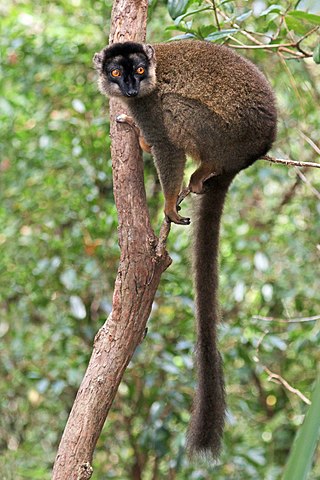
Plasmodium is a genus of unicellular eukaryotes that are obligate parasites of vertebrates and insects. The life cycles of Plasmodium species involve development in a blood-feeding insect host which then injects parasites into a vertebrate host during a blood meal. Parasites grow within a vertebrate body tissue before entering the bloodstream to infect red blood cells. The ensuing destruction of host red blood cells can result in malaria. During this infection, some parasites are picked up by a blood-feeding insect, continuing the life cycle.
Vinckeia is a subgenus of the genus Plasmodium — all of which are parasitic alveolates. The subgenus Vinckeia was created by Cyril Garnham in 1964 to accommodate the mammalian parasites other than those infecting the primates.
Plasmodium paranucleophilum is a parasite of the genus Plasmodium subgenus Novyella. As in all Plasmodium species, P. paranucleophilum has both vertebrate and insect hosts. The vertebrate hosts for this parasite are birds.
Plasmodium brumpti is a parasite of the genus Plasmodium subgenus Sauramoeba. As in all Plasmodium species, P. brumpti has both vertebrate and insect hosts. The vertebrate hosts for this parasite are reptiles.
Plasmodium coulangesi is a parasite of the genus Plasmodium subgenus Vinckeia. As in all Plasmodium species, P. coulangesi has both vertebrate and insect hosts. The vertebrate hosts for this parasite are mammals.
Plasmodium durae is a parasite of the genus Plasmodium subgenus Giovannolaia.
Plasmodium hegneri is a parasite of the genus Plasmodium subgenus Papernaia.
Plasmodium polare is a parasite of the genus Plasmodium subgenus Papernaia.
Plasmodium uilenbergi is a parasite of the genus Plasmodium subgenus Vinckeia. As in all Plasmodium species, P. uilenbergi has both vertebrate and insect hosts. The vertebrate hosts for this parasite are mammals.
Plasmodium bucki is a parasite of the genus Plasmodium subgenus Vinckeia.As in all Plasmodium species, P. bucki has both vertebrate and insect hosts. The vertebrate hosts for this parasite are mammals.
Plasmodium percygarnhami is a parasite of the genus Plasmodium subgenus Vinckeia. As in all Plasmodium species, P. percygarnhami has both vertebrate and insect hosts. The vertebrate hosts for this parasite are mammals.
Plasmodium lemuris is a parasite of the genus Plasmodium subgenus Vinckeia.
Plasmodium sandoshami is a parasite of the genus Plasmodium subgenus Vinckeia. As in all Plasmodium species, P. sandoshami has both vertebrate and insect hosts. The vertebrate hosts for this parasite are mammals.

The common brown lemur is a species of lemur in the family Lemuridae. It is found in Madagascar and has been introduced to Mayotte.
Plasmodium vinckei is a parasite of the genus Plasmodium subgenus Vinckeia. As in all Plasmodium species, P. vinckei has both vertebrate and insect hosts. The vertebrate hosts for this parasite are rodents.

The red-fronted lemur, also known as the red-fronted brown lemur or southern red-fronted brown lemur, is a species of lemur from Madagascar. Until 2001, it was considered a subspecies of the common brown lemur, E. fulvus. In 2001, E. fulvus was split into several separate species, including Eulemur rufus, in which this species was included. In 2008, E. rufus was split into two species, the red lemur and the red-fronted lemur. E. rufus covers the population on the west coast north of the Tsiribihina River and E. rufifrons covers the population on the west coast south of the Tsiribihina River and the population in eastern Madagascar. The species split was based on genetic and morphological evidence. Mitochondrial DNA analysis indicates that E. rufifrons may be more closely related to the common brown lemur, white-headed lemur and Sanford's brown lemur than it is to E. rufus.

The red lemur, also known as the rufous brown lemur or northern red-fronted lemur, is a species of lemur from Madagascar. Until 2001, the species E. rufus was considered a subspecies of the common brown lemur, E. fulvus, after which it was classified as its own species. In December 2008, the species was split into two separate species, the red lemur, E. rufus, distributed in dry lowland forests in northwestern Madagascar, and the red-fronted lemur, E. rufifrons, distributed in southwest and eastern Madagascar. The species split was based on genetic and morphological evidence. Mitochondrial DNA analysis indicates that E. rufifrons may be more closely related to the common brown lemur, white-headed lemur and Sanford's brown lemur than it is to E. rufus.
Plasmodium girardi is a malaria parasite affecting lemurs. It was described in Madagascar in 1951 in Eulemur rufus, the red-fronted lemur. It is named after Georges Girard, head of the Institut Pasteur in Antananarivo. It is one of four Plasmodium species described in lemurs before 1975; others were Plasmodium foleyi and Plasmodium lemuris.



